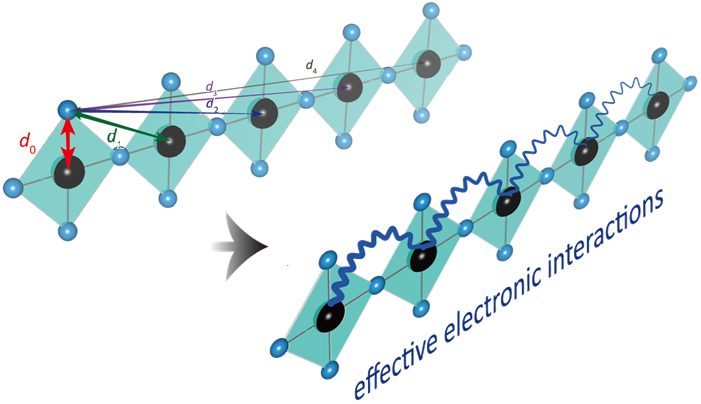Since the 1980s, scientists have been well aware of high-temperature superconducting copper-based materials, or cuprates. Below a specific temperature (roughly -130°C), electrical resistance disappears from these materials, and magnetic flux fields are released. However, the reason for that superconductivity continues to be discussed and investigated.
 A conceptual representation of the role of phonons in cuprate superconductivity. [Image Credit: Yao Wang, Clemson University].
A conceptual representation of the role of phonons in cuprate superconductivity. [Image Credit: Yao Wang, Clemson University].
It has been widely accepted that traditional superconductors result from electrons interacting with phonons, where the phonons pair two electrons as an entity and the latter can run in a material without resistance.
Yao Wang, Assistant Professor of Physics and Astronomy, Clemson University
However, in cuprates, powerful repulsions called the Coulomb force were found between electrons and were assumed to be the cause of this unique and high-temperature superconductivity.
Phonons are the vibrational energy that develops from oscillating atoms inside a crystal. The behavior and dynamics of phonons are extremely varied from those of electrons, and placing these two interacting pieces of the puzzle together has not been simple.
In the November 2021 issue of the journal Physical Review Letters, Wang, along with scientists from Stanford University, showed convincing evidence that phonons are actually contributing to a core feature witnessed in cuprates, which may specify their crucial contribution to superconductivity.
The study innovatively examined the forces of both phonons and electrons together. They demonstrated that phonons influence not only electrons in their direct vicinity, but also act on neighboring electrons that are not so close by.
"An important discovery in this work is that electron-phonon coupling generates non-local attractive interactions between neighboring electrons in space," Wang said.
When they employed only local coupling, they measured an attractive force an order of magnitude smaller than the experimental outcomes. "This tells us that the longer-range part is dominant and extends up to four unit cells," or adjacent electrons.
Wang, who headed the computational side of the project, used the National Science Foundation (NSF)-funded Frontera supercomputer at the Texas Advanced Computing Center (TACC) — the world’s fastest academic system — to reproduce in simulation experiments performed at the Stanford Synchrotron Radiation Lightsource and reported in the September 2021 issue of the journal Science.
The results depend not only on Frontera's super-fast parallel computing capabilities, but also on a novel mathematical and algorithmic technique that facilitates a much greater accuracy than before.
The technique, known as variational non-Gaussian exact diagonalization, can carry out matrix multiplications on billions of elements.
It's a hybrid method. It treats the electron and phonon by two different approaches that can adjust with each other. This method performs well and can describe strong coupling with high precision.
Yao Wang, Assistant Professor of Physics and Astronomy, Clemson University
The method development was financially backed by a grant from NSF.
The presentation of phonon-mediated attraction has a huge impact even surpassing the scope of superconductors.
"Practically, the results mean we've found a way to manipulate Coulomb interactions," Wang said, talking about the attraction or repulsion of objects or particles due to their electric charge.
"If superconductivity comes from Coulomb forces only, we cannot easily manipulate this parameter," he said. "But if part of the reason comes from the phonon, then we can do something, for instance, putting the sample on some substrate that will change the electron-phonon interaction. That gives us a direction to design a better superconductor."
This research gives new insights into the mystery of cuprate superconductivity that may lead to higher temperature superconducting materials and devices. They may find their way into future cell phones and quantum computers. A journey started by human creativity, clever algorithms, and Frontera.
Daryl Hess, Program Director, Division of Materials Research, NSF
Wang and coworker Cheng-Chien Chen, from the University of Alabama, Birmingham, also applied this new method and robust TACC supercomputers to explore laser-induced superconductivity. They published these findings in Physical Review X in the November 2021 issue. Furthermore, collaborating with a team from Harvard, Wang used TACC supercomputers to investigate the formation of Wigner crystals, details of which have been reported in Nature in June 2021.
As is the case in a number of fields of science, supercomputers are the solo tool that can investigate quantum behavior and elucidate the underlying science at play.
"In physics, we have very beautiful frameworks to describe an electron or an atom, but when we're talking about real materials with 1023 atoms, we don't know how to use these beautiful frameworks," Wang said.
In the case of quantum or correlated materials, physicists have had a challenging time applying ‘beautiful' theory. "So instead, we use ugly theory – numerical simulation of the materials. Although we don't have a well-established quantum computer, for now, using classical high-performance computers, we can push the problem forward a lot. Ultimately, this will guide experiment."
Wang is presently working with IBM and IonQ to create quantum algorithms to test on existing and future quantum computers. "Supercomputing is our first step."
Concerning big future advances in technology, Wang believes computational studies, along with experiment, observation and theory, will help unravel mysteries and accomplish practical goals, such as tunable superconducting materials.
A new algorithm can make a difference. More numerical precision can make a difference," he said. "Sometimes we don't understand the nature of a phenomenon because we didn't look closely enough at the details. Only when you push the simulation and zoom in to the nth digit will some important aspect of nature show up.
Yao Wang, Assistant Professor of Physics and Astronomy, Clemson University
Journal Reference:
Wang, Y., et al. (2021) Phonon-Mediated Long-Range Attractive Interaction in One-Dimensional Cuprates. Physical Review X. doi.org/10.1103/PhysRevLett.127.197003.